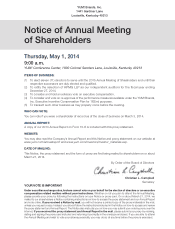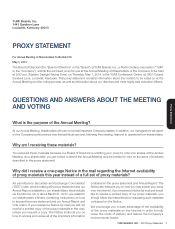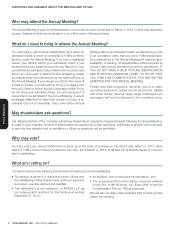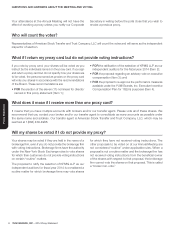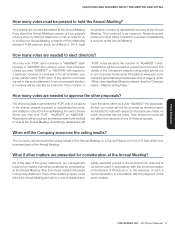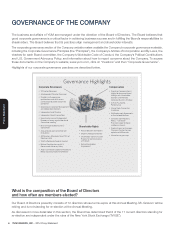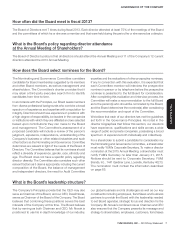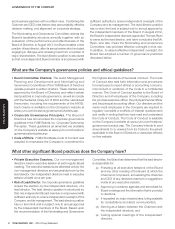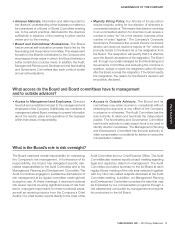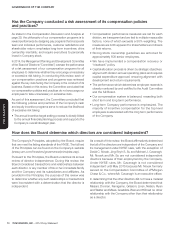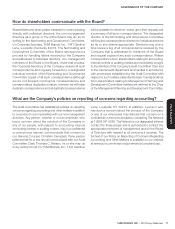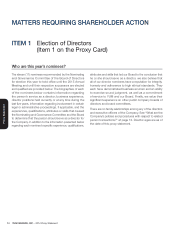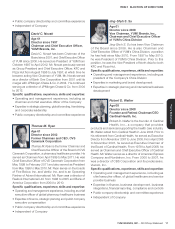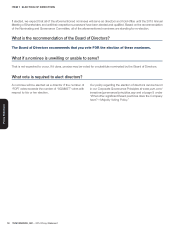Pizza Hut 2013 Annual Report Download - page 30
Download and view the complete annual report
Please find page 30 of the 2013 Pizza Hut annual report below. You can navigate through the pages in the report by either clicking on the pages listed below, or by using the keyword search tool below to find specific information within the annual report.
YUM! BRANDS, INC.-2014Proxy Statement8
Proxy Statement
GOVERNANCE OF THE COMPANY
and business partners with a unified voice. Combining the
Chairman and CEO roles fosters clear accountability, effective
decision-making, and alignment on corporate strategy.
The Nominating and Governance Committee reviews the
Board’s leadership structure annually together with an
evaluation of the performance and effectiveness of the
Board of Directors. In August 2012, the Board created a new
position of lead director, after its annual review which included
engaging in dialogue and receiving input from a number of
major shareholders. The lead director position is structured
so that one independent Board member is empowered with
sufficient authority to ensure independent oversight of the
Company and its management. The lead director position
has no term limit and is subject only to annual approval by
the independent members of the Board. In August 2012,
the Board’s independent directors appointed Thomas Ryan
to serve as the lead director, and have concluded that Mr.
Ryan, who also chairs the Nominating and Governance
Committee, has provided effective oversight in this role.
In addition, to assure effective independent oversight, the
Board has adopted a number of governance practices
discussed below.
What are the Company’s governance policies and ethical guidelines?
•
Board Committee Charters. The Audit, Management
Planning and Development and Nominating and
Governance Committees of the YUM Board of Directors
operate pursuant to written charters. These charters were
approved by the Board of Directors and reflect certain
best practices in corporate governance, as well as comply
with the Sarbanes-Oxley Act of 2002 and the rules issued
thereunder, including the requirements of the NYSE.
Each charter is available on the Company’s website at
www.yum.com/investors/governance/charters.asp.
•
Corporate Governance Principles. The Board of
Directors has documented its corporate governance
guidelines in the YUM! Brands, Inc. Corporate Governance
Principles. These guidelines as amended are available
on the Company’s website at www.yum.com/investors/
governance/principles.asp.
•
Code of Ethics. YUM’s Worldwide Code of Conduct was
adopted to emphasize the Company’s commitment to
the highest standards of business conduct. The Code
of Conduct also sets forth information and procedures
for employees to report ethical or accounting concerns,
misconduct or violations of the Code in a confidential
manner. The Code of Conduct applies to the Board of
Directors and all employees of the Company, including
the principal executive officer, the principal financial officer
and the principal accounting officer. Our directors and the
senior-most employees in the Company are required to
regularly complete a conflicts of interest questionnaire
and certify in writing that they have read and understand
the Code of Conduct. The Code of Conduct is available
on the Company’s website at www.yum.com/investors/
governance/conduct.asp. The Company intends to post
amendments to or waivers from its Code (to the extent
applicable to the Board of Directors or executive officers)
on this website.
What other significant Board practices does the Company have?
•
Private Executive Sessions. Our non-management
directors meet in executive session at each regular Board
meeting. The executive sessions are attended only by the
non-management directors and are presided over by the
lead director. Our independent directors meet in executive
session at least once per year.
•
Role of Lead Director. Our corporate governance guidelines
require the election, by the independent directors, of a
lead director. The lead director position is structured so
that one independent Board member is empowered with
sufficient authority to ensure independent oversight of the
Company and its management. The lead director position
has no term limit and is subject only to annual approval
by the independent members of the Board. Based upon
the recommendation of the Nominating and Governance
Committee, the Board has determined that the lead director
is responsible for:
(a)
Presiding at all executive sessions of the Board
and any other meeting of the Board at which the
Chairman is not present, and advising the Chairman
and CEO of any decisions reached or suggestions
made at any executive session,
(b)
Approving in advance agendas and schedules for
Board meetings and the information that is provided
to directors,
(c) If requested by major shareholders, being available
for consultations and direct communication,
(d) Serving as a liaison between the Chairman and
the independent directors, and
(e) Calling special meetings of the independent
directors.



